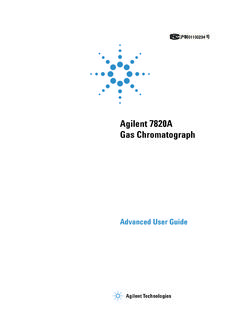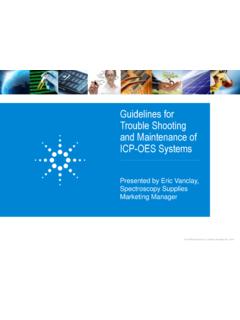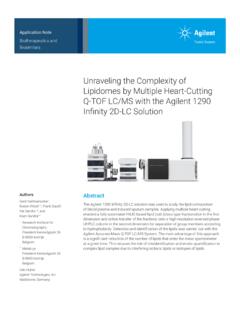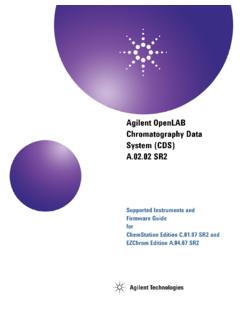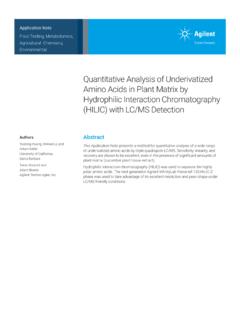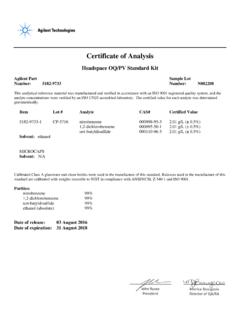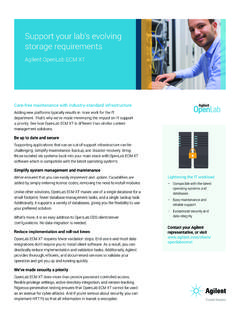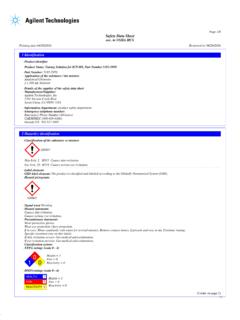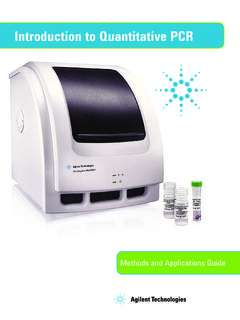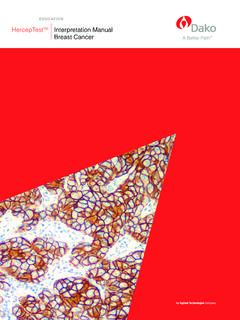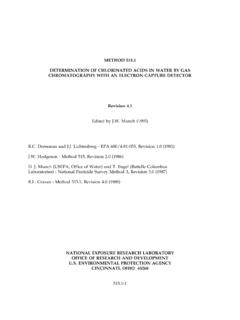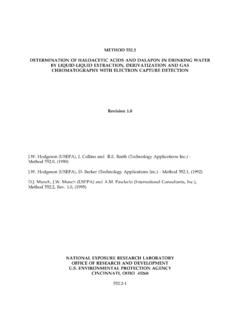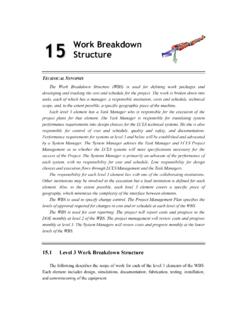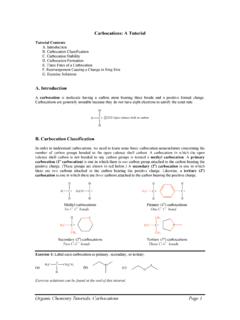Transcription of SAFETY DATA SHEET - Agilent
1 Section 1. IdentificationElectron capture Detectors_ECDCHEMTREC : 1-800-424-9300 SAFETY data SHEETP roduct nameIn case of emergency::Supplier/Manufacturer: Agilent Technologies, Stevens Creek BlvdSanta Clara, CA 95051, USA800-227-9770 electron capture Detectors_ECDC onforms to US OSHA Hazard Communication , G2397-60510, G2397AC, G2397AB, G2397-65505, G2397AD, G2397-60511,G2397-60512, G2397-65506, G2397AE, G2397-60560, G2397-60620, G2397-65550,G2397-60610, G2398A, G2398AB, G2398AC, G2398AD, G2397-60515, G2397-60615,G2397-60625, G2398-60515, G2398-60615, G2398-60625, G4597A, G3958A, G7356A,G4593-60610, G4593-60617, G4598A, G7357A, G7358A, G4593-60618, G3450-60610,G3450-60611, G3450-60612, G3450-60613, G3450-60430, G3450-60431,G3450-60432, G3450-60433, G3450-60434, G3450-60435, G3450-60436,G3450-60437, G3450-60438, G3450-60439, G3450-60471, G3450-60472,G3450-60473, G3450-60474, G3450-60475, G3450-60476, G3450-60477,G3450-60478, G3450-60481, G3450-60482, G3450-60483, G3450-60484.
2 G3562A,G3563A, G3564A, G2355A, G2365A, G2375A, G2377A, G1223A:Part uses:Reagents and Standards for Analytical Chemistry Laboratory UseThe ECD contains a 15 mCi source of radioactive Nickel-63. This source is enclosed within a steel housing. May be contained in: G1530N/ G1530N-EU, G1540N / G1540N-EU, G2690A,G1944A, G2630A/ G2630B, G3440A, G3440B, G3442B, G3443B, G3445B, G3950A,G3952A, G3953A, G3540A, G2790A, G3545A, RMN3540A, RMN2790 AValidation date:12/10 Relevant identified uses of the substance or mixture and uses advised againstThis product is considered an article. This SAFETY data SHEET is written based on the encapsulated substance or mixture in this Product Details of the supplier of the SAFETY data Emergency telephone numberSection 2. Hazards identificationClassification of the substance or mixtureOSHA/HCS status:This material is considered hazardous by the OSHA Hazard Communication Standard (29 CFR ).
3 This article, when used under reasonable conditions and in accordance with the directions for use, should not present a health hazard. The substance or mixture is encapsulated in the article. Only if released due to use or processing of the article in a manner not in accordance with the product s directions for use it may present potential health and SAFETY SENSITIZATION - Category 1H351 CARCINOGENICITY - Category 2H372 SPECIFIC TARGET ORGAN TOXICITY (REPEATED EXPOSURE) (respiratory tract)(inhalation) - Category 1H412 AQUATIC HAZARD (LONG-TERM) - Category Classification of the substance or mixture1/13 Date of issue :12/10/2018 electron capture Detectors_ECDS ection 2. Hazards identificationSignal word:DangerHazard statements:H317 - May cause an allergic skin - Suspected of causing - Causes damage to organs through prolonged or repeated exposure if inhaled.
4 (respiratory tract)H412 - Harmful to aquatic life with long lasting pictograms:Precautionary statementsPrevention:P201 - Obtain special instructions before - Do not handle until all SAFETY precautions have been read and - Wear protective gloves. Wear eye or face protection. Wear protective - Avoid release to the - Do not breathe - Do not eat, drink or smoke when using this - Wash hands thoroughly after (OSHA) - Contaminated work clothing must not be allowed out of the :P314 - Get medical attention if you feel + P313 - IF exposed or concerned: Get medical + P352 + P363 - IF ON SKIN: Wash with plenty of soap and water. Wash contaminated clothing before + P313 - If skin irritation or rash occurs: Get medical :P405 - Store locked :P501 - Dispose of contents and container in accordance with all local, regional, national and international GHS label elementsHazards not otherwise classified:None Other hazardsSection 3.
5 Composition/information on ingredientsNickel, isotope of mass 63100 13981-37-8 Ingredient nameCAS number%Substance/mixture:Occupational exposure limits, if available, are listed in Section (encapsulated in article)Any concentration shown as a range is to protect confidentiality or is due to batch are no additional ingredients present which, within the current knowledge of the supplier and in the concentrations applicable, are classified as hazardous to health or the environment and hence require reporting in this article, when used under reasonable conditions and in accordance with the directions for use, should not present a health hazard. The substance or mixture is encapsulated in the article. Only if released due to use or processing of the article in a manner not in accordance with the product s directions for use it may present potential health and SAFETY of issue :12/10/2018 electron capture Detectors_ECDWash out mouth with water.
6 Remove dentures if any. Remove victim to fresh air and keep at rest in a position comfortable for breathing. If material has been swallowed and the exposed person is conscious, give small quantities of water to drink. Stop if the exposed person feels sick as vomiting may be dangerous. Do not induce vomiting unless directed to do so by medical personnel. If vomiting occurs, the head should be kept low so that vomit does not enter the lungs. Get medical attention. Never give anything by mouth to an unconscious person. If unconscious, place in recovery position and get medical attention immediately. Maintain an open airway. Loosen tight clothing such as a collar, tie, belt or flush eyes with plenty of water, occasionally lifting the upper and lower eyelids. Check for and remove any contact lenses. Continue to rinse for at least 10 minutes.
7 Get medical with plenty of soap and water. Remove contaminated clothing and shoes. Wash contaminated clothing thoroughly with water before removing it, or wear to rinse for at least 10 minutes. Get medical attention. In the event of any complaints or symptoms, avoid further exposure. Wash clothing before reuse. Clean shoes thoroughly before victim to fresh air and keep at rest in a position comfortable for breathing. If not breathing, if breathing is irregular or if respiratory arrest occurs, provide artificial respiration or oxygen by trained personnel. It may be dangerous to the person providing aid to give mouth-to-mouth resuscitation. Get medical attention. If unconscious, place in recovery position and get medical attention immediately. Maintain an open tight clothing such as a collar, tie, belt or 4. First aid measuresEye contactSkin contactInhalationIngestion::::Protection of first-aiders:No action shall be taken involving any personal risk or without suitable training.
8 It may be dangerous to the person providing aid to give mouth-to-mouth resuscitation. Wash contaminated clothing thoroughly with water before removing it, or wear to physician:Treat symptomatically. Contact poison treatment specialist immediately if large quantities have been ingested or Description of necessary first aid measuresSpecific treatments:No specific Most important symptoms/effects, acute and delayedInhalation:If vaporized, and all vapors were to be inhaled, the person would receive a dose of rem. If a source were to be ground into 1 micrometer diameter particles and all particles were to be inhaled, the total body dose would be approximately remNo known significant effects or critical the source were to be eaten, the person would receive a dose of known significant effects or critical hazards.:IngestionSkin contact:May cause an allergic skin known significant effects or critical hazards.
9 :Eye contactOver-exposure signs/symptomsSkin contactIngestionInhalationNo specific specific symptoms may include the following:irritationredness:::Eye contact:No specific acute health effectsSee toxicological information (Section 11) Indication of immediate medical attention and special treatment needed, if necessary3/13 Date of issue :12/10/2018 electron capture Detectors_ECDS ection 5. Fire-fighting measuresPromptly isolate the scene by removing all persons from the vicinity of the incident if there is a fire. No action shall be taken involving any personal risk or without suitable thermal decomposition productsSpecific hazards arising from the chemicalDecomposition products may include the following materials:metal oxide/oxidesThis material is harmful to aquatic life with long lasting effects. Fire water contaminated with this material must be contained and prevented from being discharged to any waterway, sewer or should wear appropriate protective equipment and self-contained breathing apparatus (SCBA) with a full face-piece operated in positive pressure protective equipment for fire-fightersUse an extinguishing agent suitable for the surrounding Extinguishing media:::None extinguishing media:Unsuitable extinguishing media:Special protective actions for fire- Special hazards arising from the substance or Advice for firefightersSection 6.
10 Accidental release Environmental Personal precautions, protective equipment and emergency procedures::No action shall be taken involving any personal risk or without suitable surrounding areas. Keep unnecessary and unprotected personnel from entering. Do not touch or walk through spilled material. Provide adequate appropriate respirator when ventilation is inadequate. Put on appropriate personal protective dispersal of spilled material and runoff and contact with soil, waterways, drains and sewers. Inform the relevant authorities if the product has caused environmental pollution (sewers, waterways, soil or air). Water polluting material. May be harmful to the environment if released in large containers from spill area. Avoid dust generation. Do not dry sweep. Vacuum dust with equipment fitted with a HEPA filter and place in a closed, labeled waste container.
